As with the kiwi, New Zealand’s penguins need people to help them survive. And as with the kiwi, New Zealanders are doing just that. The folks at the Penguin Place have been helping protect yellow-eyed penguins on the Otago Peninsula, outside of Dunedin, since 1985. New Zealanders say yellow-eyed penguins are the rarest penguins in the world, numbering between 4,000 and 5,000.
Lucky for me, Alma College’s New Zealand Experiences in 2006, 2008 and 2010 all included an opportunity to see yellow-eyed penguins. Our appointments for Penguin Place were always late in the day because that’s when penguins return to land after spending a day at sea. Each “tour” started with an introduction by one of the guides, then we jumped into a van, rode up and down a few hills, then played follow the leader behind the guide as we searched for penguins.
The first thing I noticed was the view.
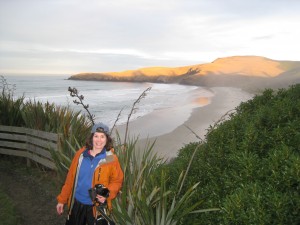
Then I looked inland and saw open areas interspersed with covered trenches.
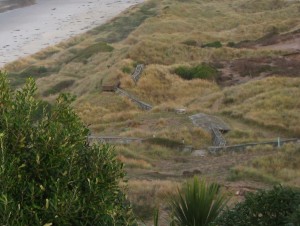
The trenches connect to what look like underground dug-outs with long narrow openings at the top so people can peer out and take photographs while the penguins work their way through the land maze. In fact, the whole preserve was designed to allow the penguins to come and go with minimal interference from people.
The penguin’s goal when they return from the sea is to reach their huts, which consists of a simple lean-to. Since the huts offer little protection, the Penguin Place folks also set traps for rats and other nasties. The rest, of course, is up to the penguins.
In 2006 and 2008 I was lucky enough to see a couple of penguins, but both times it was nearly dark and I never got a photo I wanted to show anyone. In May of 2010, I was following a guide in the pouring rain and having doubts of getting any photos at all. We were within 10 yards of the first dug-out shelter when I heard the high-pitched call of a penguin, followed almost immediately by the emergence from some nearby shrubs of not one, not two, but three penguins in a row. They measured only 26 inches high but their very presence caused the line of people behind me to stop suddenly. We all held our breath and bust out in grins as the three penguins stopped, glanced at us for a moment, and trudged on and out of sight.
It was still pouring rain, so the guide led us into the nearby shelter where we waited for more penguins to show up. The guides all carry walkie-talkies, and a voice soon came on to report that Al was on his way, and that we should wait for him. So we waited. And waited. We were about to give up on Al when we saw him.
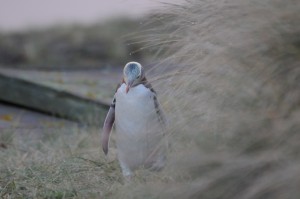
He trudged along like I do after a long day at work. He took a few more steps and came fully into view. I love his pink feet.

After a few moments, Al stopped and looked our way.

He wiggled his flippers, put his head down and continued toward us.
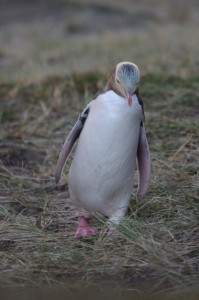
He came within a few feet of the shelter before turning.
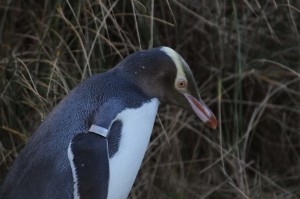
Suddenly, he stopped and turned.
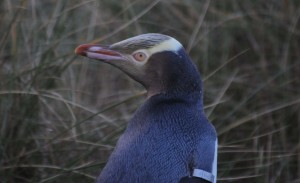
After giving us another mug shot, he turned away again, walked a bit more, then stopped for one last look.
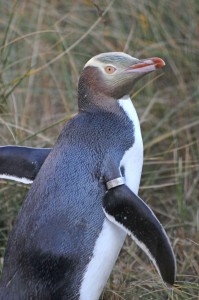
And with that, Al put his head down and walked out of sight.
It was such an amazing experience. I was grinning from ear to ear as we followed the guide over land again, through a few trenches, and over land. We saw several other penguins–including Howie and Tarzan–but none came as close as Al. The rain eventually stopped, allowing me to snap a few more photos, including this penguin outside his triangular home.
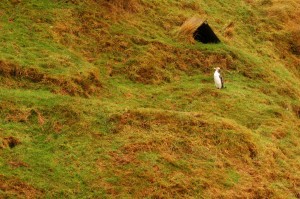
The thing is, these are the lucky penguins, the ones that made it past the predator we saw in the water.

The guide told us that a sea lion was likely responsible for a sudden and recent decline in the local population of yellow-eyed penguins, the females in particular.
As we drove back over the rolling hills in the dark of night, my heart felt heavy for the males that had lost a mate and for the local New Zealand people that had come to know the females that died. At the same time, I also felt a sense of awe to have been in the midst of several endangered penguins the local people have done so much to protect.
Keep up the good work, Penguin Place. Keep up the fight, little penguins.